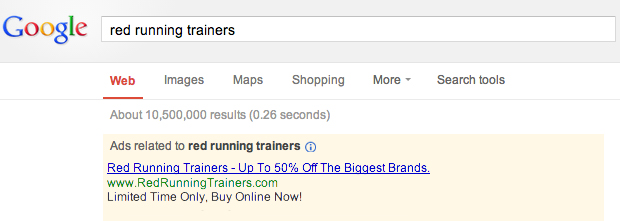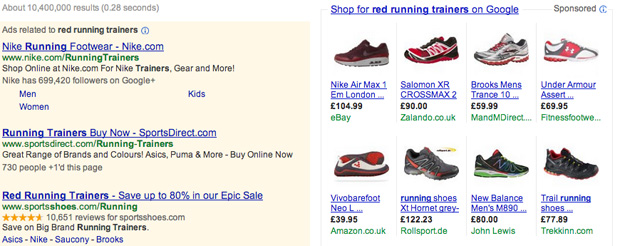One of the most difficult aspects of managing a Pay Per Click (PPC) account is a difficult customer who believes they know better than you, despite paying you for your expertise. But the customer’s always right, you say? Not when you can prove them wrong using a beautiful platform called Google Analytics!
Naturally, we’re not suggesting belittling your client as a strategy to shut them up — otherwise known as the “I Am an Obnoxious Pig” strategy. We’re just saying that from the start, customer education is vital. Your customer has to know that PPC is advertising, and as such is not guaranteed to get a high return every single month despite our best efforts.
–The definition of PPC advertising you need to get across to the customer
The Oxford Dictionary defines the word advertising as:
“ … to describe or draw attention to (a product, service, or event) in a public medium in order to promote sales or attendance: for example a billboard advertising beer … ”
And one of our personal PPC heroes, Larry Kim, defines Pay Per Click as:
“… a method of advertising in which advertisers pay for each ad clicked, usually via an advertising platform such as Google AdWords.”
If we combine the two, we get an accurate definition of PPC:
“Pay-per-click advertising is a method of drawing attention to a website (and their product, service or event) in which advertisers pay for each ad clicked in order to promote sales or attendance through the website.”
–Example
Lets say we’re promoting a pair of red running trainers (as us Brits call them). The process could go like this:

- User X searches Google for “red running trainers”
- User X gets to the search engine results page (SERP) with your ad in a great position amongst other options on the page.As PPC managers, this is the only point in the process where we have any real control. This is where our interesting, appealing ad — from a good campaign with high ad positions — may lead to the user clicking through to our website’s landing page.
- User X clicks on your ad, looks about your landing page and website.
THE INTERNET PROVIDES USERS WITH CHOICES, 99 TIMES OUT OF 100 THEY WON’T PURCHASE ON THE FIRST SITE THEY VISIT!!!

Sadly, the problem with an industry like this is that user X is going to browse and look at other options on different sites. Ultimately their decision will be made on what sites they’ve clicked on, the product they want, price, reviews, trust & delivery options.
In this example, you would see your ads competing with Nike, Amazon, Ebay and Sports Direct (a major sports clothing retailer in the UK) amongst others.
The lesson here is that while PPC is an effective method of advertising, it is only as effective as the landing page and website the ad links to. The job of the PPC ad is to encourage the user to come to our client’s site and if we are working/advising on the design then we can build landing pages that are built to increase conversions. Beyond that, we’re not setting their prices or running their business for them, so we can’t guarantee sales.
–Good old ROI and why it isn’t always 100% accurate in your reports
The problem with return-on-investment (ROI) figures in PPC reports is that they are not always 100% accurate. Firstly, many people make the mistake of not differentiating between Return on Ad Spend (ROAS) and ROI (particularly if they use Google Analytics).
ROAS is a great place to start when figuring out ROI, but it’s a terrible place to land. That’s because a true ROI requires a much more complex definition of the costs.
ROAS needs just one cost — the cost of your PPC campaign. For example, if you spent £500 on a PPC campaign and gained £1000 in sales from it, your ROAS is a simple 100%. But ROI is more complicated, because it needs a cost figure that includes your total cost for selling the product or service.
How much does fulfilment on orders generated by PPC cost? What about payment processing costs, shipping costs, salaries, and office rental? ROI is a more robust number because it’s a more comprehensive number. That makes it a more useful number, too.
Even if you have the total cost numbers available for your calculations, you’re still likely to only be getting a fuzzy idea of the true ROI. For example, John’s buying an iPad and comes across one on a second-hand iPad website.
John likes the price and is about to buy, when he notices they are just a 10-minute drive from his home. Rather than have to wait a couple of days for delivery and pay shipping fees, he decides to go to the shop and buys it there. In your reports, this sale from PPC is therefore not recorded.
Over the years, various studies have demonstrated the effectiveness of PPC campaigns for offline as well as online sales. Revtrax conducted a study from August 2009 to August 2011 analysing the effects of online marketing on offline sales.
The PPC analysed in this study used coupons to drive customers, which isn’t typical in all PPC, but the results were startling: PPC drove six times more offline sales than online sales! These findings (which you can view here) are out of date today, but that’s still an amazing difference.
More recently, Vodafone hired UK company Carat to study the performance of generic keyword advertising in terms of both in-store customer behaviour and sales. Carat concluded that PPC advertising increased offline sales by 3% (you can see the results here).
Both of these examples definitely demonstrate the clear link between PPC and offline sales, but for a smaller business it’s naturally more difficult to effectively track PPC results in offline sales channels.
One solution to the problem of tracking offline sales generated from PPC campaigns is using unique phone numbers when taking orders over the phone.
Using a unique number in ads using call extensions or having a unique number on landing pages built for PPC will tell you immediately what the source of your customer’s interest is and compiles some real numbers about offline sales from PPC ads. A great review of phone-tracking practices was written by Brad Geddes (another PPC hero of ours); you can read it here.
We have a few hotels that we manage PPC campaigns for, and while the ROI is accurate for online bookings and bookings made over the phone, it does not take into account the actual ROI based on how much the customer paid overall during their stay — in the restaurant, at the bar, in the spa, etc.
In hotels where all of these activities are electronically linked to billing based on room number, it’s possible to collect this data and incorporate it into the true ROI calculation. Some of our hotel clients, however, don’t have this capability and lack the resources to perform this sort of data collection manually.
As a result, the ROI in our reports for these hotels doesn’t look very impressive at first glance, because it’s missing all of this cost and earnings data — it only shows online and phone sales (and even then, only if the phone sales are being tracked).
The ROI may be much higher when all of the data is taken into consideration, and it’s vital that this be communicated to your customers at the very beginning. Their understanding of the need for complete data and the inaccuracy that can result from its absence is extremely important.
–OK, so you had a Poor Month in Terms of PPC Revenue, how did your offline advertising go?
When you send out your monthly PPC report it’s easy for the customer to see the ROI (or ROAS…) of each campaign if the report is set up in the right way. So if it’s low compared to a previous month they’re likely to ask why you didn’t warn them and the reasons it’s lower if you haven’t communicated these answers to them already.

However, when you take a step back and look at the whole picture, you can see that the PPC maybe didn’t actually perform so badly. In comparison to the rest of the advertising budget, there may have been huge amounts spent on adverts on radio & TV, in newspapers and magazines, flyering, billboards and whatever else they choose. When you compare you have to investigate the following questions:
- How many people have been driven to your website or business?
- How many of these people have been targeted, relevant traffic?
- How many new customers have you received and have the opportunity to promote to in the future?
When you weigh it up you are likely to find that in fact, PPC was one of, if not the best way for the money to be spent. It’s easy in PPC reports to pick out that sales weren’t as high as last month, but there are many other benefits PPC advertising has brought to your business.
It will have increased brand awareness with new visitors to your site and people seeing your adverts, you may have gained increased numbers on your mailing list, more followers on Twitter or likes on Facebook and if you’re clever you can continue to remarket to the new visitors on your site!
Communication remains the most important facet of your customer relationship. Regular, clear communication – in person or on the phone – is the only way to ensure that you’re still on the same page when it comes to their marketing goals.
The scale and size of their marketing plan – whether 3-, 6-, or 12-months – doesn’t change the basics. You need to know where PPC fits in with their overall strategy and you must be the expert in the room who can tell them how PPC can benefit their business – and explain to them why sometimes it doesn’t appear to be working as well as expected.
–Here’s My Advice
As a digital marketing agency working in web design, SEO, and PPC we always find it easier when we are managing the whole package. Unfortunately for all clients, this is not always the case.
All we can do is perform an honest assessment of their web presence and marketing efforts, identify weaknesses and opportunities they are missing, and offer possible explanations based on this analysis as to why customers are choosing to purchase elsewhere.
We can’t force anyone to heed our advice – and sometimes our advice is unwanted for the precise reason that it hits too close to home. In those circumstances we know we did what we could, and we move on to someone who does want and appreciate our help.


